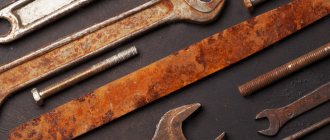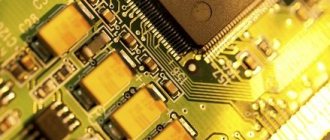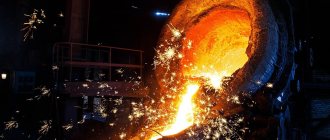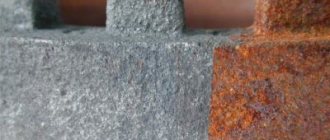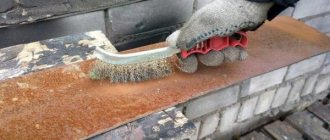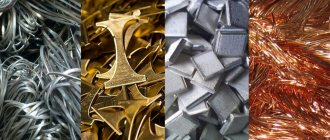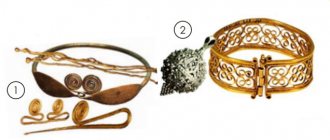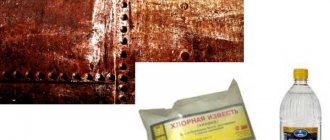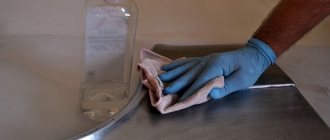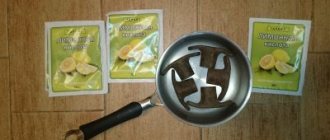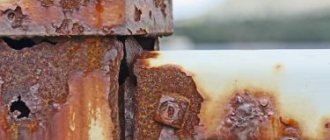Metal sellers are well acquainted with the manifestation of metal corrosion such as rust and know how much damage it can cause. According to various statistics, metal corrosion can “eat up” 10-20 percent of global iron production. And, unfortunately, not only the metal itself is destroyed, but also products made from it. Roofs, bridges, fences, cars, buildings, and even the symbol of Paris, the Eiffel Tower, rust and are destroyed by corrosion.
In addition to the destruction of various structures that can pose a threat to human life, the rusting of metals often causes environmental damage: leakage of harmful chemicals when pipelines are destroyed, leakage of oil and gases from tanks “corroded” by corrosion, etc. Today we will try to figure out what rust is, how to prevent its appearance, and whether it is possible to get rid of it when it has already appeared on the surface of metal products.
Damage, damage...
Everyone has seen those orange-brown or yellowish rust spots on metal parts. The economic damage from metal corrosion is enormous. In the USA and Germany, the estimated damage from corrosion and the costs of combating it amount to approximately 3% of GDP. At the same time, metal losses, including due to the failure of structures, products, and equipment, amount to up to 20% of the total steel production per year. For Russia, exact data on losses from corrosion have not been calculated.
It is known for certain that it was rusted metal structures that caused the collapse of several bridges in the United States, including with numerous casualties. Environmental damage is also extremely unpleasant: leakage of gas and oil due to the destruction of pipelines leads to environmental pollution.
Protection of metals from corrosion
In modern conditions, both traditional and innovative technologies and techniques are used to slow down or prevent metal corrosion processes:
- New metal alloys are being developed and introduced into production;
- Special protective coatings are applied to the surfaces;
- Reduce aggressive external influences, etc.
For example, the characteristics of stainless steel have excellent resistance to corrosion. Although steel contains iron, this material does not rust. The whole secret is that the stainless steel alloy contains chromium and other elements that change the properties of the alloy. This process is called steel alloying and allows you to obtain rolled steel with the desired characteristics.
Types of corrosion and its causes
Before talking about rust on iron, let's briefly look at its other types.
Not only metals, but also non-metallic products are susceptible to corrosion. In this case, corrosion is also called “aging”. Plastics, rubbers and other substances are subject to aging. For concrete and reinforced concrete there is a term "fatigue". They are destroyed or their performance characteristics deteriorate due to chemical and physical exposure to the environment. Metal alloys - copper, aluminum, zinc - also corrode: during their corrosion, an oxide film is formed on the surface of the product, tightly adhering to the surface, which significantly slows down the further destruction of the metal (and the patina on copper also gives it a special charm). Precious metals are such not only because of their beauty, valued by jewelers, but also because of their resistance to corrosion. Gold and silver are still used to coat particularly sensitive electronic contacts, and platinum is used in the space industry.
The metal can corrode in some areas of the surface (local corrosion), cover the entire surface (uniform corrosion), or destroy the metal along the grain boundaries (intercrystalline corrosion). Corrosion accelerates noticeably with increasing temperature.
Folk remedies for removing rust and hardening the surface layer
1.During the Great Patriotic War, in case of corrosion damage to weapons, soldiers cleaned the rust with the following composition:
- hydrochloric acid,
- inhibitors of plant origin.
Hydrochloric acid destroys corrosion products, plant inhibitors adsorb these compounds on themselves. An oxidation-reduction reaction occurs. As a result, rust disappears, and a protective film is formed on the surface, preventing the development of corrosion processes.
2.When removed from the ground, rusty iron objects are capable of accumulating organic substances that were in the soil (carbon, nitrogen, etc.) in the surface layer. Heat treatment of such products (water hardening) leads to hardening of the surface layer. Mechanical properties are improved and hardness increases.
Types of Rust
Iron is more susceptible to corrosion. From a chemical point of view, rust is an oxidative process (like combustion). Elements resulting from oxidation in an oxygen environment are called Oxides. There are 4 main types.
1. Yellow rust - chemical formula FeO(OH)H2O (ferrous oxide). Occurs in a humid, oxygen-poor environment. Often found underwater. In nature, it exists in the form of the mineral wustite, while being a monoxide (it contains 1 oxygen atom).
2. Brown rust - Fe2O3 (double iron oxide): grows without water and is rare.
3. Black rust - Fe3O4 (tetravalent iron oxide). Formed with low oxygen content and without water, it is therefore stable and spreads very slowly. This oxide is ferromagnetic (under certain conditions it is magnetized in the absence of an external magnetic field), therefore it is potentially applicable for the creation of superconductors.
4. Red rust - chemical formula Fe2O3•H2O (ferric oxide). Occurs under the influence of oxygen and water, the most common type, the process proceeds evenly and affects the entire surface. Unlike all of the above types of oxidation, which are not so dangerous for iron, this one forms iron hydroxide in its thickness, which, when it begins to peel off, opens up more and more layers of metal for destruction. The reaction can continue until the structure is completely destroyed. It is used in iron smelting and as a dye in the food industry. It occurs naturally in nature under the name hematid.
Several types of rusting can occur simultaneously without particularly interfering with each other.
Chemical and electrochemical corrosion
Iron rusts if it contains additives and impurities (such as carbon) and comes into contact with water and oxygen. If salt (sodium and potassium chloride) is dissolved in water, the reaction becomes electrochemical and the rusting process accelerates. The massive use of these salts both in household chemicals and for combating ice and snow makes electrochemical corrosion a very common and dangerous phenomenon: losses in the United States from the use of salts in winter amount to $2.5 billion. When exposed to water and oxygen simultaneously, iron hydroxide is formed, which, unlike oxide, peels off from the metal and does not protect it in any way. The reaction continues either until the iron is completely destroyed or until the system runs out of water or oxygen.
Electrochemical corrosion can be caused by stray currents that occur when part of the current leaks from an electrical circuit into aqueous solutions or into the soil and from there into a metal structure. In those places where stray currents exit metal structures back into water or soil, metal destruction occurs. Stray currents occur especially often in places where ground electric transport moves (for example, trams and electric railway locomotives). In just one year, stray currents with a force of 1A are capable of dissolving 9.1 kg of iron, 10.7 kg of zinc, and 33.4 kg of lead.
In the second part of the article we will tell you how you can protect your metal structures from this scourge or defeat it if it is already attacking.
Ways to combat corrosion
Today, various methods are used to protect metals from corrosion. The choice is determined by the operating conditions of metal products, including the climate of the region, the characteristics of the metal structure itself, as well as the compatibility of the anti-corrosion composition and the material being processed, and other factors.
All types of combating metal corrosion can be divided into three main ones, aimed at changing one of the factors:
- properties of the metal itself;
- environmental properties;
- the nature of the interaction between the metal product and the environment at the contact boundary.
Changing the properties of metal to prevent corrosion
This group of methods includes alloying, surface and heat treatment. The first two can be classified as chemical methods. The third is to technological methods.
Alloying involves the inclusion in the composition of the metal during its production of chemical elements that are least likely to enter into a chemical reaction with oxygen. These components, in increasing order of chemical efficiency, are arranged in the following order: chromium, copper, zinc, silver, aluminum, platinum.
Another method is metallization (galvanic method), when the surface of the product is coated with a metal that is more resistant to oxygen. It is supplied in finely dispersed form in the form of an ionized stream. These include cold galvanizing and hot galvanizing.
To protect against corrosion, phosphating or oxalation can also be used - treating the metal surface with phosphate salts of manganese and zinc, or oxalic acid.
Heat treatment means heating the metal to a temperature above +900◦C. As a rule, it is used in combination with saturation of the workpiece surface with chromium, nitrogen, aluminum, silicon and other elements that increase the metal’s resistance to corrosion.
The methods of protection listed above are classified as active. This also includes the transformation of the structure of the electrical double layer - anodization. The metal surface is exposed to a constant electric field with specified voltage parameters, which are selected in accordance with the properties of the metal. This increases its electrode potential and increases the corrosion resistance of the top layer. This method is usually used to create anti-corrosion protection for aluminum.
Changes in environmental properties
The parameters of the environment surrounding a metal product can be changed by inhibiting it, deoxygenating it, drying the air mixture and eliminating aggressive substances - salts, acids and others.
If the object is small, a vacuum can be created around it: there is practically no oxygen left in the air, and accordingly, the risk of corrosion is minimized.
Another method is to fill the space around a metal part or structure with an inert gas (neon, xenon, argon). This method gives a high effect, but is quite difficult to use: it is necessary to install a protective chamber, as well as the availability of special protective suits for people servicing metal equipment. It is usually used in research laboratories and pilot production sites where it is necessary to maintain a special microclimate.
Changing the nature of the interaction of metal with the environment
This is an anti-corrosion treatment of metal, for which a wide variety of methods are used.
- Protective coatings - varnishes and paints, oils, lubricants and so on.
- Elimination of cathodic polarization in the form of contact-type corrosion protection, electrical drainage, removal of stray currents, and so on.
- Competent design of metal structures, in which the most resistant metal to the influence of factors of a particular environment is selected, gaps, stagnant zones, contact of dissimilar metals, and so on are eliminated.
To combat metal corrosion, paint and varnish coatings are widely used. Today this option is used especially often. Special organic paints and varnishes are used, the components of which do not react with oxygen, as well as compositions with aluminum. The first ones block access to O₂. The latter do not allow corrosion destruction of steel due to the presence of a chemically inert element in the composition - aluminum. In addition, protective films and liquid plastic are used - a relatively new solution.
The effectiveness of such protection is influenced by the quality of preparation of the metal surface for coating, the uniformity of its application, the thickness and strength of the layer, the exclusion of the formation of air cavities and other factors.
This method is characterized by ease of implementation and low financial costs. However, the effect is short-lived: over time, mechanical destruction of the coating occurs. It is also important to understand that paintwork materials and films prevent the appearance of corrosion, but are not able to prevent it, which gives grounds to call this method of corrosion protection passive. You can coat rusty metal with a special paint that transforms the rust and creates an anti-corrosion protective layer.
Unusual methods include a high-viscosity technological lubricant made from iron oxides - Fe3O4. The temperature of formation of this substance is +250-500°C. It can be used to treat metal so that it does not rust. Forming a dense film on the surface, Fe3O4 prevents oxygen from penetrating the metal, preventing tribochemical corrosion from developing. This method is used at metallurgical enterprises in the process of high-speed upsetting of alloys and hard-to-deform metals.
Methods for removing corrosion
If rust has already appeared on the metal, the risk of destruction of parts or structures increases sharply. It is necessary to remove corrosion, for which it is proposed to use one of the methods.
- Manual mechanical cleaning is the traditional option. The surface of the product is treated with a metal brush, sandpaper or an abrasive wheel. You can do this manually or using a drill with an appropriate attachment, or an angle grinder. The method requires a lot of effort and a lot of time.
- Special chemical compounds that react with iron oxide. This option is relevant for products whose shape is complex and the surface is corrugated. However, this method cannot be used on products with non-metallic components. In addition, working with such products requires special care, since they can be harmful to human health.
- Electrochemical method. The metal product is immersed in an electrolyte solution, connected to an electric current source. The current passing through the electrolyte and the part causes a layer of rust to separate from its surface. But this option is not suitable for all metal products.
- Sandblasting, shot blasting, and ultrasound clean the metal of iron oxide, beating it off the surface.
- Dry ice (cryoblasting) – cleansing using a jet of dry ice granules. When hitting metal, ice particles evaporate. Carbon dioxide is released: instantly expanding, it captures and removes rust.
Investments in protecting metal from corrosion can extend the service life of parts and structures, and, therefore, increase the frequency of their replacement.
The maximum effect is achieved by combining several methods. For example, to preserve metal elements underwater, a combination of cathodic protection and coatings is used. Anti-corrosion protection of propeller guide nozzles includes the use of corrosion-resistant steel, electrical separation of dissimilar materials, cathodic protection and paintwork materials.
